37 structures cross the Seine in Paris. Some of these, like the Pont des Arts, the Pont Alexandre III and the Pont Neuf, are world-famous; others are fairly nondescript, like the concrete affairs carrying the boulevard périphérique or the simple Pont Saint-Louis. Here are my favourites.
6: Pont Rouelle
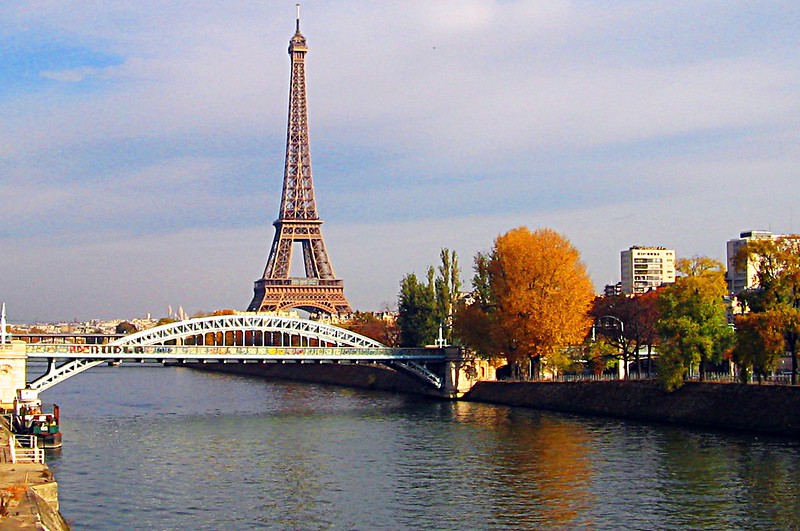
One of only two railway-only bridges crossing the Seine in Paris, the Pont Rouelle carries a branch of RER line C across the river and over the beautiful Île aux Cygnes. The only bridge that curves over the Parisian Seine, it was built to carry a line linking the Ligne d’Auteuil (part of the Petite Ceinture) with the Champ de Mars, one of the main sites of the 1900 Exposition Universelle, where it connected with the line from Versailles to Invalides. The line opened just in time, three days before the exposition started.
After a very successful first year in service, passenger numbers soon declined in the face of competition from the rapidly expanding metro. From 1924, passenger trains stopped using the bridge, followed by freight in 1936. It stood disused for several decades before eventually being integrated into the RER network in 1988. Now, trains crossing the bridge carry passengers from as far away as the distant suburbs of Pontoise and Dourdan.
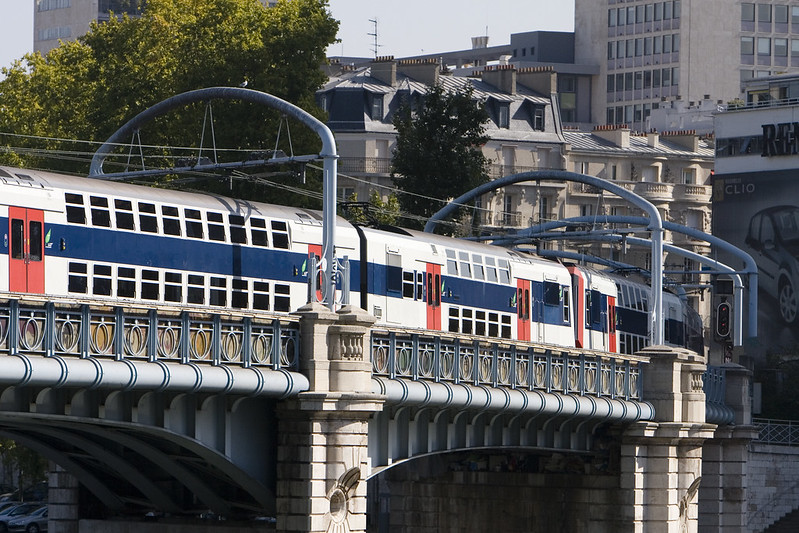
Either side of the Île aux Cygnes, the bridge takes different forms. Between the left bank and the island, the curved iron bridge rests on two intermediate stone piers; on the other side, the rails are carried by a single-span arch bridge. On the island itself, a small stone arch links the two, crossing over the tree-lined walkway which had to be lowered slightly.
Designed by architect Bonnet and engineers Moïse and Widmer, the bridge takes its name from a nearby street, itself named after an 18th-century French chemist.
5: Passerelle Léopold-Sédar-Senghor
In at number 5 is a footbridge which links the Musée d’Orsay with the Jardin des Tuileries. The third bridge on the site, it was completed in 1999 to replace a steel footbridge dating from 1961, which itself replaced a cast-iron bridge built 100 years earlier. Formerly known as the Passerelle de Solférino to mark a Franco-Sardinian military victory, it received its new name in 2006 to mark the centenary of the birth of Senegalese statesman and intellectual Léopold Sédar Senghor. The battle remains honoured in the name of a nearby street and metro station.
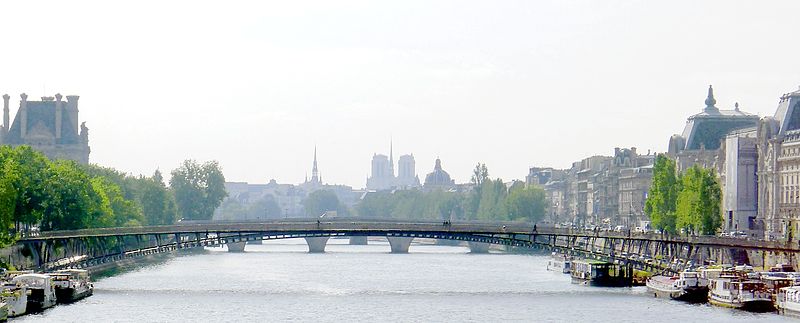
The current bridge was designed by engineer Marc Mimram and won him the Équerre d’Argent, a French architecture award. Its single arched span holds two decks, one above the other, which connect in the middle. This allows pedestrians to connect with both the pedestrianised lower riverbanks and the quays above, which carry roads. On the right bank, the lower deck of the bridge leads into an underpass allowing pedestrians to access the Jardin des Tuileries without crossing traffic.
The steel structure supports a wooden deck, with seats in the same wood at intervals along both sides. The bridge affords views of the Musée d’Orsay, the Louvre and, in the distance, the Notre-Dame.
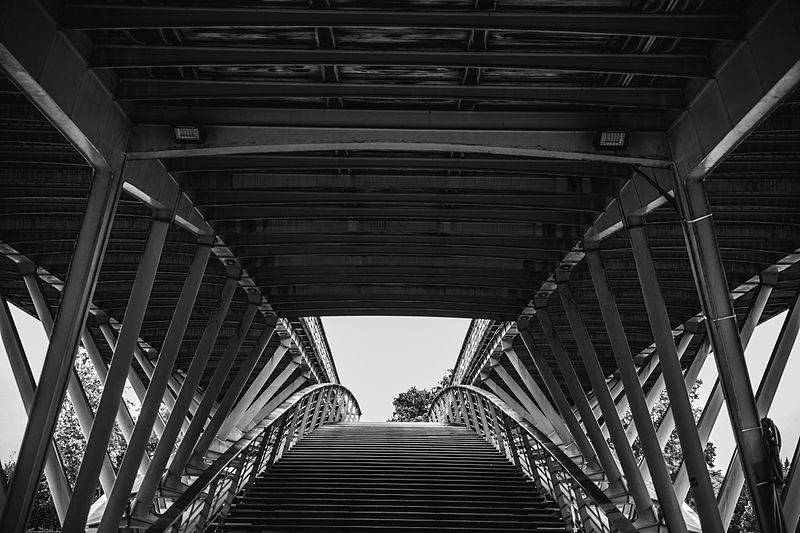
4: Pont de Bir-Hakeim
When the Pont Rouelle was constructed, it was the third bridge to cross the Île aux Cygnes. 300 m downstream stood the cast-iron Pont de Grenelle (since replaced), while 500 m upstream, at the island’s northeastern tip, stood a footbridge known as the Passerelle de Passy. This bridge was built for the Exposition Universelle in 1878 and was popular with locals.
At the end of the 19th century, Paris adopted Fulgence Bienvenüe’s ambitious proposal to build the city’s first ten metro lines. One of these, the Circulaire Sud (south circular), needed to cross the river twice to link up with the Circulaire Nord (line 2). One of these crossings was at Passy, where the opportunity was taken to replace the existing bridge with one that could carry trains and road traffic as well as pedestrians.
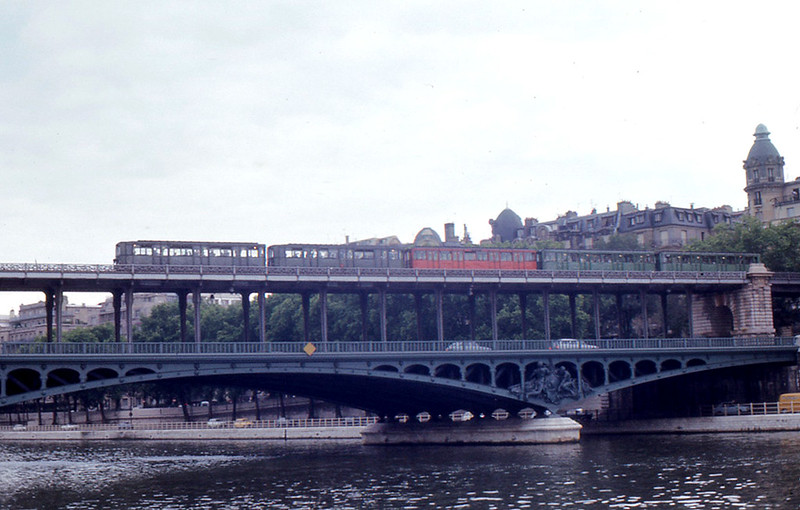
The bridge, designed by Jean-Camille Formigé (also known for gardens in Auteuil and Montmartre), comprises two unequal portions, one either side of the island, each composed of steel arches sitting on two stone piers. The main deck carries cars and pedestrians, while an upper viaduct carries trains. The viaduct crosses the island on an ornate stone arch, and is supported for the rest of its length by elegant, slender steel pillars in an Art Nouveau style. The street is lit by lamps hanging down from the viaduct.
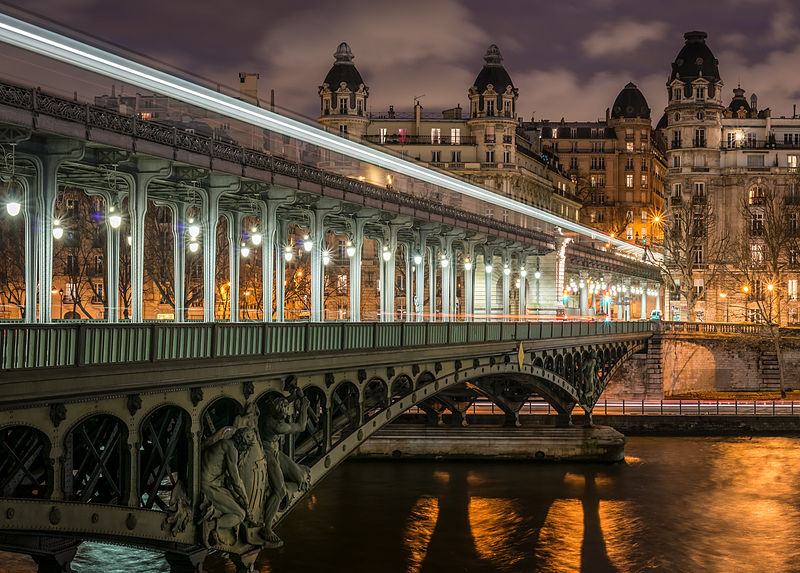
The bridge and the station to the south took their current name in 1949, commemorating the 1942 Battle of Bir-Hakeim, a Second World War battle in the Libyan desert. It has great views of the Eiffel Tower, directly adjacent on the left bank. Its iconic design, combined with its proximity to the Tower, have led it to be featured in a number of films, including Last Tango in Paris and Inception.
3: Pont de Bercy
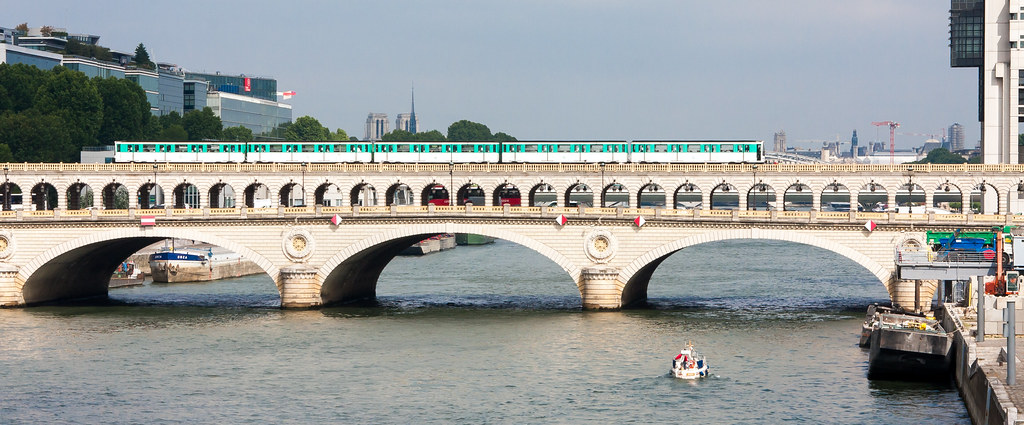
Line 6’s other river crossing point is at Bercy, where the line crosses the Paris metro’s only stone viaduct. Unlike at Bir-Hakeim, this viaduct was built on top of a pre-existing bridge, completed in 1864. The bridge was widened in 1904 to make room for the metro, and then further widened in 1992 to double the road traffic capacity. Before this widening, the metro viaduct stood on one side of the bridge; the extension, designed by neoclassical architect Christian Langlois, brought symmetry to the structure, without compromising the original design. Unlike the rest of the stone bridge, the extension was made of reinforced concrete finished in stone.
The Pont de Bercy isn’t the first river crossing at the site. A ferry was replaced in 1832 by a suspension bridge. But after the 1860 expansion of Paris – which brought the site inside the city limits – this bridge could no longer meet the capacity demands of the area. The new bridge was part of the extensive renovation project of Baron Haussmann.
As at Passy, motor traffic flows either side of the viaduct and the section underneath the railway plays host to a two-way cycle lane.

Of the two bridges carrying metro line 6, Bir Hakeim has tended to receive more attention than its eastern counterpart. Personally, I appreciate the uniqueness of the stone viaduct, more reminiscent of 19th-century long-distance railways than a city metro. The arches also remind me of the splendid porticoes of the Louvre and the Place des Vosges. And while Bir Hakeim sits adjacent to Paris’s most well-known structure, the Pont de Bercy affords views of some of the city’s more recent wonders, such as the 1996 Bibliothèque François Mitterrand, the 1988 Finance Ministry and the 2009 Cité de la Mode et du Design.
2: Viaduc d’Austerlitz
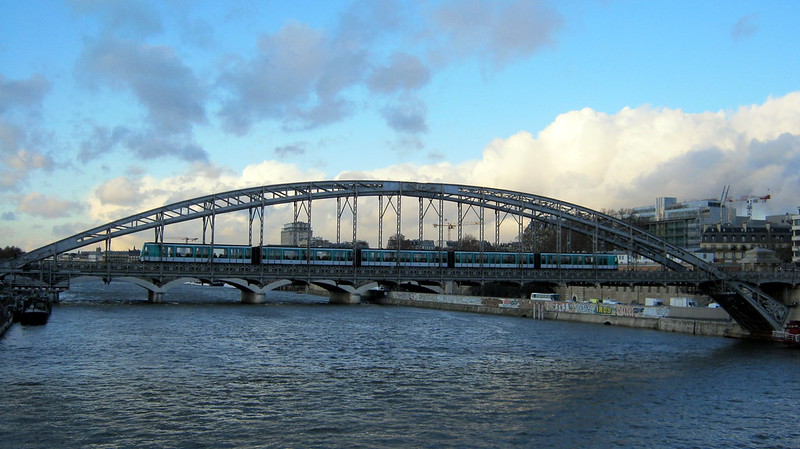
Railways cross over the Seine at 4 places in Paris, and all of them have made my top 6. The Viaduc d’Austerlitz, which opened in 1906 to carry metro line 5 from Quai de la Rapée to the Gare d’Austerlitz, is the most beautiful of all. Crossing the river in a single, 140 metre span, the deck is suspended from two parabolic steel arches. Until the completion of the nearby Pont Charles-de-Gaulle in 1996, this was the longest span of any bridge in Paris.
The bridge, like the Pont de Bir-Hakeim, was designed by architect Jean-Camille Formigé and engineer Louis Biette, this time with help from “father of the Metro” Fulgence Bienvenüe. Detail on the arches, principally marine motifs, was designed by Formigé, and since 2000 has been highlighted by lighting at night during service hours.
On the right bank, the viaduct continues into the Viaduc du Quai de la Rapée, which curves through 90 degrees and descends steeply to join the metro station of the same name. On the left bank, the viaduct leads directly into the upper levels of the Gare d’Austerlitz, a mainline station. Riding line 5 across the river and into the station is a wonderful experience.
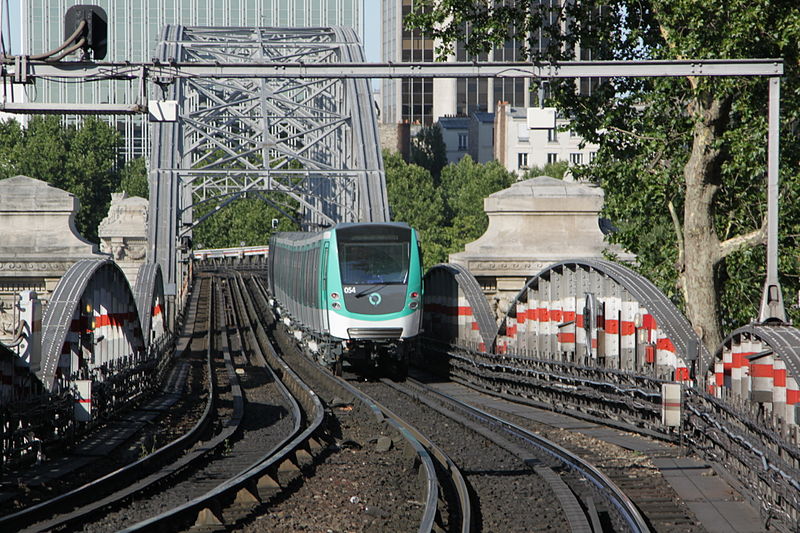
1: Passerelle Simone-de-Beauvoir
The newest of the city’s 37 bridges over the Seine, completed in 2006, is a footbridge between the Bibilothèque François Mitterrand and the Parc de Bercy. It connects two of Paris’s most rapidly developing neighbourhoods: the Quartier de la Gare in the 13th arrondissement, and Bercy in the 12th. These neighbourhoods, situated outside the city walls until 1860, have seen massive transformation since the 1980s.
Like the Passerelle Léopold-Sédar-Senghor, this bridge has two levels. On the left bank, the upper level leads directly onto the vast plaza of the Biblothèque, with the lower level accessing the quayside road. A lift connects the two and also leads down to the lower riverside, a bustling pedestrianised area with restaurants and bars both on- and offshore. On the right bank, the upper level accesses the Parc de Bercy, while the lower level connects to both the busy riverside road and the port at the water’s edge.
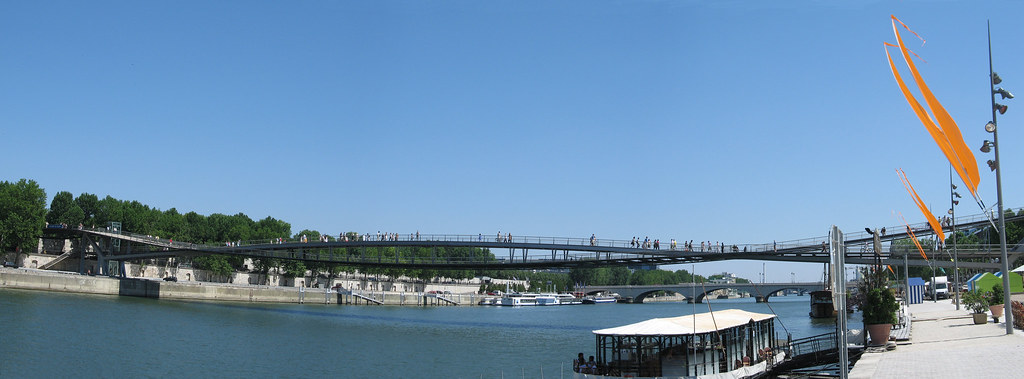
In common with the Passerelle Léopold-Sédar-Senghor, the Passerelle Simone-de-Beauvoir crosses the river in a single steel span and has a wooden deck. But it’s a quite different bridge in engineering terms, consisting not of two arches but of an arch and a catenary, forming a lenticular truss (for a more detailed analysis, see this wonderful article by the Happy Pontist). The bridge won a Footbridge Award in 2008, one of two that year for Austrian architect Dietmar Feichtinger.
The central lens creates a sheltered seating area, a perfect place for pedestrians to stop and drink in the architectural surroundings, including a great view of the Pont de Bercy. Either end of the bridge the lower and upper sections meet, but not in a completely symmetrical manner: on the left bank, the central section forms the upper level, whereas on the right bank it dips below the side arms, which link up to lead into the park.
The bridge’s name was chosen in 2005 by then-mayor of Paris Bertrand Delanoë. It celebrates influential French feminist Simone de Beauvoir.
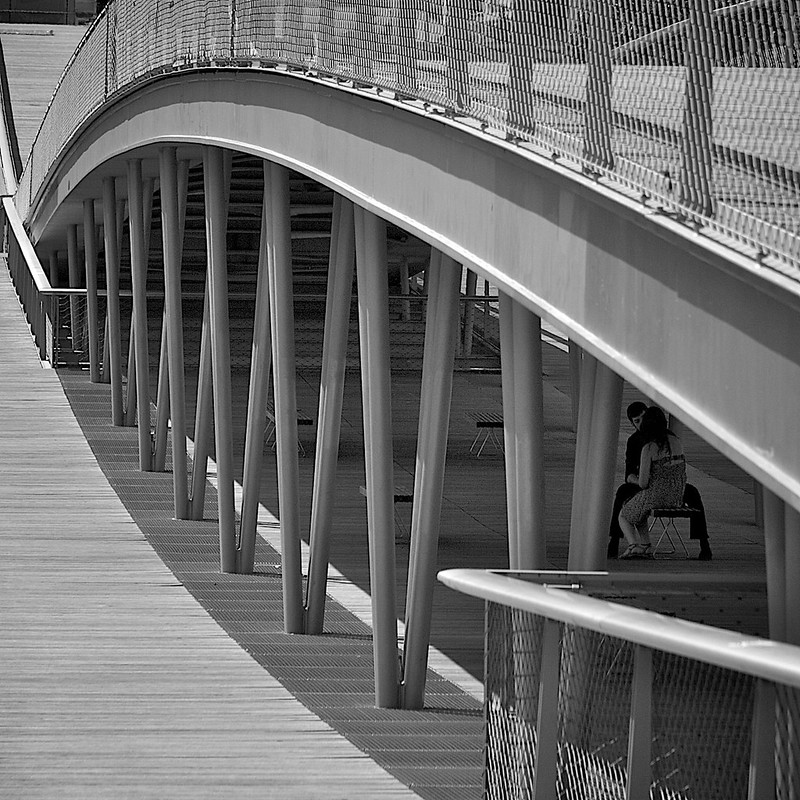
If you strongly agree or disagree with any part of this ranking, please get in touch to tell me why I’m wrong! Of course, Paris has many other bridges that don’t cross the Seine. I’ll explore my favourite of these in a future article.
Addendum
Roger Goodacre got in touch to point out a bit of information I’d missed regarding the Passerelle Léopold-Sédar-Senghor. It was found to have a dangerous wobble that needed to be fixed after the initial opening – exactly as happened with London’s Millennium Bridge the following year. On top of this, the slick wooden deck was found to get too slippery when wet, and had to be coated with a nonslip material, again after its opening.
 Fabric of Paris
Fabric of Paris